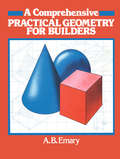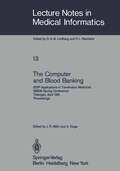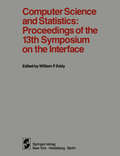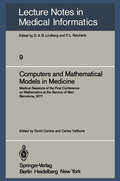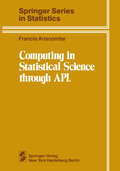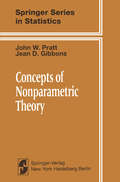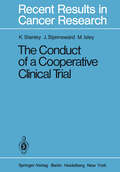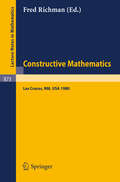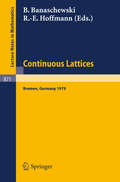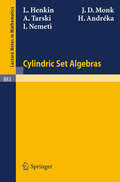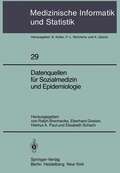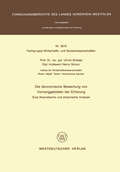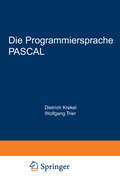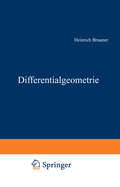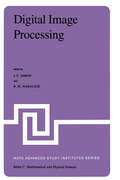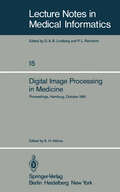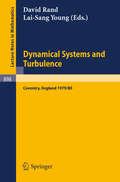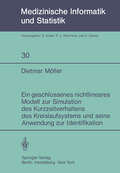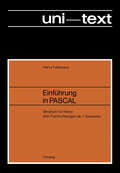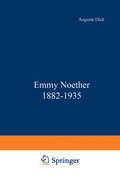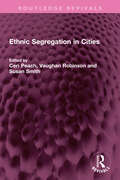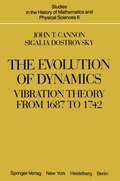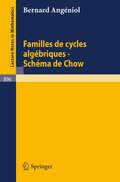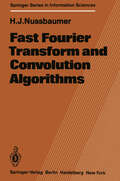- Table View
- List View
The Computer and Blood Banking: (EDP Applications in Transfusion Medicine) GMDS Spring Conference Tübingen, April 9–11, 1981 Proceedings (Lecture Notes in Medical Informatics #13)
by J. R. Möhr A. KlugeComputer Science and Statistics: Proceedings of the 13th Symposium on the Interface
by W. F. EddyThe 13th Symposium on the Interface continued this series after a one year pause. The objective of these symposia is to provide a forum for the interchange of ideas of common concern to computer scientists and statisticians. The sessions of the 13th Symposium were held in the Pittsburgh Hilton Hotel, Gateway Center, Pittsburgh. Following established custom the 13th Symposium had organized workshops on various topics of interest to participants. The workshop format allowed the invited speakers to present their material variously as formal talks, tutorial sessions and open discussion. The Symposium schedule was also the customary one. Registration opened in late afternoon of March 11, 1981 and continued during the opening mixer held that evening: The formal opening of the Symposium was on the morning of March 12. The opening remarks were followed by Bradley Efron's address "Statistical Theory and the Computer." The rest of the daily schedule was three concurrent workshops in the morning and three in the afternoon with contributed poster sessions during the noon break. Additionally there were several commercial displays and guided tours of Carnegie-Mellon University's Computer Center, Computer Science research facilities, and Robotics Institute.
Computers and Mathematical Models in Medicine: Medical Sessions of the First Conference on Mathematics at the Service of Man Barcelona, July 11–16, 1977 (Lecture Notes in Medical Informatics #9)
by David Cardús and Carlos VallbonaThe papers gathered in this volume were presented at the medical sessions of the First Conference on Mathematics at the Service of Man held in Barcelona, Spain, July 11-16, 1977. Papers presented at the medical sessions were more numerous than those pre sented in any other single area of specialization covered in the conference. Because pf this, the Publications Committee resolved that papers presented at medical sessions be published separately from the proceedings of the conference. The proceedings of the conference have been published by the Esco1a Tecnica Superior d'Arquitectura de 1a Universitat Po1itecnica of Barcelona. The papers contained in this volume were selected on the basis of current interest and willingness of the authors to publish. They are organized not accord ing to the sequence in which they were presented at the conference, but, to the extent that this was possible, in topic areas. As its name indicates, the principal purpose of the conference was to under score the fact that mathematics is a science whose applications are relevant to many aspects of human activity. In the opinion of the editors of this volume, the conference met its objective with success, both in terms of the broad variety of topics covered as well as by the number of nations that were represented at the conference in spite of the special circumstances prevailing in Spain at that time.
Computing in Statistical Science through APL (Springer Series in Statistics)
by Francis John AnscombeA t the terminal seated, the answering tone: pond and temple bell. ODAY as in the past, statistical method is profoundly affected by T resources for numerical calculation and visual display. The main line of development of statistical methodology during the first half of this century was conditioned by, and attuned to, the mechanical desk calculator. Now statisticians may use electronic computers of various kinds in various modes, and the character of statistical science has changed accordingly. Some, but not all, modes of modern computation have a flexibility and immediacy reminiscent of the desk calculator. They preserve the virtues of the desk calculator, while immensely exceeding its scope. Prominent among these is the computer language and conversational computing system known by the initials APL. This book is addressed to statisticians. Its first aim is to interest them in using APL in their work-for statistical analysis of data, for numerical support of theoretical studies, for simulation of random processes. In Part A the language is described and illustrated with short examples of statistical calculations. Part B, presenting some more extended examples of statistical analysis of data, has also the further aim of suggesting the interplay of computing and theory that must surely henceforth be typical of the develop ment of statistical science.
Concepts of Nonparametric Theory (Springer Series in Statistics)
by J.W. Pratt J.D. GibbonsThis book explores both non parametric and general statistical ideas by developing non parametric procedures in simple situations. The major goal is to give the reader a thorough intuitive understanding of the concepts underlying nonparametric procedures and a full appreciation of the properties and operating characteristics of those procedures covered. This book differs from most statistics books by including considerable philosophical and methodological discussion. Special attention is given to discussion of the strengths and weaknesses of various statistical methods and approaches. Difficulties that often arise in applying statistical theory to real data also receive substantial attention. The approach throughout is more conceptual than mathematical. The "Theorem-Proof" format is avoided; generally, properties are "shown," rather than "proved." In most cases the ideas behind the proof of an im portant result are discussed intuitively in the text and formal details are left as an exercise for the reader. We feel that the reader will learn more from working such things out than from checking step-by-step a complete presen tation of all details.
The Conduct of a Cooperative Clinical Trial (Recent Results in Cancer Research #77)
by K. E. Stanley J. Stjernswärd M. IsleyThe purpose of this monograph is to address the basic mecha nisms for organizing trials. Is is meant to serve as a guide to individuals planning to form a cooperative group as well as to cooperative groups who wish to revise and refine their existing procedures. Current literature deals with many components of conducting clinical trials, such as trial design considerations, randomization, and methods of analysis. But there is a lack of accessible knowledge concerning data flow, data processing, and group organization which causes difficulty for many multi institutional cooperative trials. Multi-institutional cooperative studies require greater atten tion to detail than studies within a single institution. For single institution studies, a single protocol document may be suffi cient. In a cooperative group, however, it is necessary to standardize various aspects where little variation may be pre sent in a single institution study. Patients must be entered in a uniform fashion, data collection and evaluation should be standardized, and there must be a mechanism to insure the timely collection of essential data.
Constructive Mathematics: Proceedings of the New Mexico State University Conference Held at Las Cruces, New Mexico, August 11-15, 1980 (Lecture Notes in Mathematics #873)
by F. RichmanContinuous Lattices: Proceedings of the Conference on Topological and Categorical Aspects of Continuous Lattices (Workshop IV) Held at the University of Bremen, Germany, November 9-11, 1979 (Lecture Notes in Mathematics #871)
by B. Banaschewski R. E. HoffmannCylindric Set Algebras (Lecture Notes in Mathematics #883)
by L. Henkin J. D. Monk A. Tarski H. Andreka I. NemetiDatenquellen für Sozialmedizin und Epidemiologie (Medizinische Informatik, Biometrie und Epidemiologie #29)
by R. Brennecke E. Greiser H. A. Paul E. SchachDie ökonomische Bewertung von Vorranggebieten der Erholung: Eine theoretische und empirische Analyse (Forschungsberichte des Landes Nordrhein-Westfalen #3015)
by Ulrich BrösseDifferentialgeometrie
by Heinrich Braunerum das zur Lösung konkreter geometrischer Einzelfragen nötige Rüstzeug zu ver mitteln, ist auch stets die koordinatenmäßige Behandlung berücksichtigt. Verzichtet wurde auf den Differentialformenkalkül, doch wird der Leser keine Schwierigkeiten haben, sich diese für die moderne Differentialgeometrie wichtige Methode auf der Grundlage des Buches selbst anzueignen. In einer Einführung sollten nach meiner Ansicht nicht verschiedene methodische Ansätze verwendet werden. Der gebotene Stoff geht in Umfang und Inhalt über eine etwa vierstündige Vor lesung hinaus und gestattet den Anschluß eines weiterführenden Seminars. Die sorg fältig angebrachten zahlreichen Rückverweisungen ermöglichen es, verschiedenartige Lehrgänge aus dem Inhalt zusammen zu stellen. Freunde konkreter Geometrie wer den die Diskussionen im Anschluß an den induzierten Zusammenhang in KapitelS überschlagen, die Krümmungstheorien in Kapitel 6 nur für Hyperflächen behandeln und sich vor allem den 2-Flächen in Kapitel 7 zuwenden. Das andere Extrem ist die Auswahl eines Lehrgangs über differenzierbare Mannigfaltigkeiten und Riemannsche Geometrie; dabei kann man mit Kapitel 8 beginnen und die Rückverweisungen dazu verwenden, Beispiele für die eingeführten Begriffe bereitzustellen. Die Abschnitte 3. 3,4. 3,5. 5 und 6. 5 und das Kapitel 7 müssen nicht studiert werden, um jeweils nach folgende Abschnitte verstehen zu können, der Abschnitt 3. 5 wird erst in 8. 8 benötigt. Der Abschnitt 8. 8 ist unter Verwendung einzelner Rückverweisungen auch ohne die vorhergehenden Abschnitte des Kapitels 8 lesbar. Jedem Kapitel ist eine kurze Inhaltsübersicht vorangestellt, und jeder Abschnitt schließt mit einer Sammlung von Aufgaben zur Einübung des behandelten Stoffes.
Digital Image Processing: Proceedings of the NATO Advanced Study Institute held at Bonas, France, June 23 – July 4, 1980 (Nato Science Series C: #77)
by J. C. Simon R. HaralickThis book is the consequence of a NATO ASI held at the Chateau de BONAS, from June 23 to July 4, 1980. It contains the tutorial lectures and some papers presented at the Institute. The book is divided in four sections: Issue.s-, of general interest. Some topics are broader than the proper techniques of image processing, such as complexity, clustering, topology, physiology; but they may be of interest ... Feature detect'ion and evaluation. The first level feature detections are examined: edges and textures. Reorganization and improvement of the results are obtained by relaxation and opti mization process. Cooperative process are examined. Scenes and shapes. concerns higher level problems, and representation of images such as map and line-drawings. Applications in remote sensing, scene analysis, of one or of a sequence of images. It is hoped that this book will serve to update a domain In fast evolution. Acknowledgment: This ASI, and this book, have been made possible by the financial support of the NATO Scientific Affairs Division, and the material support of INRIA and the Institut de Programmation of the Universite P. et M. Curie. vii J. C. Simon and R. M. Haralick (eds.), Digital Image Processing, vii. Copyright © 1981 by D. Reidel Publishing Company. APPLICATION OF COMPLEXITY OF COMPUTATIONS TO SIGNAL PROCESSING S. Winograd IBM Thomas J. Watson Research Center Yorktown Heights, New York, U.S.A.
Digital Image Processing in Medicine: Proceedings, Hamburg, October 5, 1981 (Lecture Notes in Medical Informatics #15)
by D. A. B. LindbergIn diagnostic medicine a large part of information about the patient is drawn from data, which, more or less, are represented in an opti calor pictorial form. There is a very wide range of such data as e.g. the patients appearance, the various kinds of radiological images, or cytological imagery. In conventional diagnostics the data, as it comes from the acquisition device, is perceived by the physician and is interpreted with the help of a large amount of "a priori" knowledge to give a diagnostic finding. During the last 15 years a steadily rising number of attempts have been made to support these processes by the application of com puters. The attempts mainly concentrate on three objectives: 1. Support of the perception process by the production of better or new types of images, e.g. by Computer tomography or Computer angio graphy (image processing) . 2. Automation of the interpretation process, e.g. for bloodcell dif ferentiation (pattern recognition) . 3. Management of the steeply rising amount of medical image data in the hospital (image data bases) . Although the early applications of digital methods aimed at the second . . objective, in the last years much more success has been a achieved in the support of the perception process by methods of image process ing. The reason for this is obvious - in the case of automatic interpre tation the a priori knowledge of the physician has to be formalized.
Dynamical Systems and Turbulence, Warwick 1980: Proceedings of a Symposium Held at the University of Warwick 1979/80 (Lecture Notes in Mathematics #898)
by D. A. Rand L. S. YoungEin geschlossenes nichtlineares Modell zur Simulation des Kurzzeitverhaltens des Kreislaufsystems und seine Anwendung zur Identifikation (Medizinische Informatik, Biometrie und Epidemiologie #30)
by D. MöllerEmmy Noether 1882–1935
by DICKN 1964 at the World's Fair in New York I City one room was dedicated solely to mathematics. The display included a very at tractive and informative mural, about 13 feet long, sponsored by one of the largest com puter manufacturing companies and present ing a brief survey of the history of mathemat ics. Entitled, "Men of Modern Mathematics," it gives an outline of the development of that science from approximately 1000 B. C. to the year of the exhibition. The first centuries of this time span are illustrated by pictures from the history of art and, in particular, architec ture; the period since 1500 is illuminated by portraits of mathematicians, including brief descriptions of their lives and professional achievements. Close to eighty portraits are crowded into a space of about fourteen square feet; among them, only one is of a woman. Her face-mature, intelligent, neither pretty nor handsome-may suggest her love of sci- 1 Emmy Noether ence and creative gift, but certainly reveals a likeable personality and a genuine kindness of heart. It is the portrait of Emmy Noether ( 1882 - 1935), surrounded by the likenesses of such famous men as Joseph Liouville (1809-1882), Georg Cantor (1845-1918), and David Hilbert (1862 -1943). It is accom panied by the following text: Emmy Noether, daughter of the mathemati cian Max, was often called "Der Noether," as if she were a man.
Ethnic Segregation in Cities (Routledge Revivals)
by Ceri Peach Vaughan Robinson Susan SmithFirst published in 1981, Ethnic Segregation in Cities argues that race and ethnicity are fundamental to writing about the city, and that economic patterns adapt themselves to race and ethnicity rather than vice versa. The problem of ethnic segregation is a burning one for both geographers and sociologists – geographers because of the concern for all aspects of urban deprivation, and sociologists because they are discovering that space and spatial processes are important factors in influencing social segregation or assimilation. The book brings together some of the main contributors to the literature on spatial aspects of ethnicity from both sides of the Atlantic. A variety of evidence from New York, Detroit, Bradford and Blackburn address the question of whether choice on the path of ethnic members, or constraints imposed by the host society are determinant factors influencing residential segregation. This book will be of interest to students of sociology, human geography and urban studies.
Ethnic Segregation in Cities (Routledge Revivals)
First published in 1981, Ethnic Segregation in Cities argues that race and ethnicity are fundamental to writing about the city, and that economic patterns adapt themselves to race and ethnicity rather than vice versa. The problem of ethnic segregation is a burning one for both geographers and sociologists – geographers because of the concern for all aspects of urban deprivation, and sociologists because they are discovering that space and spatial processes are important factors in influencing social segregation or assimilation. The book brings together some of the main contributors to the literature on spatial aspects of ethnicity from both sides of the Atlantic. A variety of evidence from New York, Detroit, Bradford and Blackburn address the question of whether choice on the path of ethnic members, or constraints imposed by the host society are determinant factors influencing residential segregation. This book will be of interest to students of sociology, human geography and urban studies.
The Evolution of Dynamics: Vibration Theory from 1687 to 1742 (Studies in the History of Mathematics and Physical Sciences #6)
by J. T. Cannon S. DostrovskyIn this study we are concerned with Vibration Theory and the Problem of Dynamics during the half century that followed the publication of Newton's Principia. The relationship that existed between these subject!! is obscured in retrospection for it is now almost impossible not to view (linear) Vibration Theory as linearized Dynamics. But during the half century in question a theory of Dynamics did not exist; while Vibration Theory comprised a good deal of acoustical information, posed definite problems and obtained specific results. In fact, it was through problems posed by Vibration Theory that a general theory of Dynamics was motivated and discovered. Believing that the emergence of Dynamics is a critically important link in the history of mathematical science, we present this study with the primary goal of providing a guide to the relevant works in the aforemen tioned period. We try above all to make the contents of the works readily accessible and we try to make clear the historical connections among many of the pertinent ideas, especially those pertaining to Dynamics in many degrees of freedom. But along the way we discuss other ideas on emerging subjects such as Calculus, Linear Analysis, Differential Equations, Special Functions, and Elasticity Theory, with which Vibration Theory is deeply interwound. Many of these ideas are elementary but they appear in a surprising context: For example the eigenvalue problem does not arise in the context of special solutions to linear problems-it appears as a condition for isochronous vibrations.
Familles de Cycles Algebriques - Schema de Chow (Lecture Notes in Mathematics #896)
by Bernard AngeniolFast Fourier Transform and Convolution Algorithms (Springer Series in Information Sciences #2)
by H.J. NussbaumerThis book presents in a unified way the various fast algorithms that are used for the implementation of digital filters and the evaluation of discrete Fourier transforms. The book consists of eight chapters. The first two chapters are devoted to background information and to introductory material on number theory and polynomial algebra. This section is limited to the basic concepts as they apply to other parts of the book. Thus, we have restricted our discussion of number theory to congruences, primitive roots, quadratic residues, and to the properties of Mersenne and Fermat numbers. The section on polynomial algebra deals primarily with the divisibility and congruence properties of polynomials and with algebraic computational complexity. The rest of the book is focused directly on fast digital filtering and discrete Fourier transform algorithms. We have attempted to present these techniques in a unified way by using polynomial algebra as extensively as possible. This objective has led us to reformulate many of the algorithms which are discussed in the book. It has been our experience that such a presentation serves to clarify the relationship between the algorithms and often provides clues to improved computation techniques. Chapter 3 reviews the fast digital filtering algorithms, with emphasis on algebraic methods and on the evaluation of one-dimensional circular convolutions. Chapters 4 and 5 present the fast Fourier transform and the Winograd Fourier transform algorithm.
